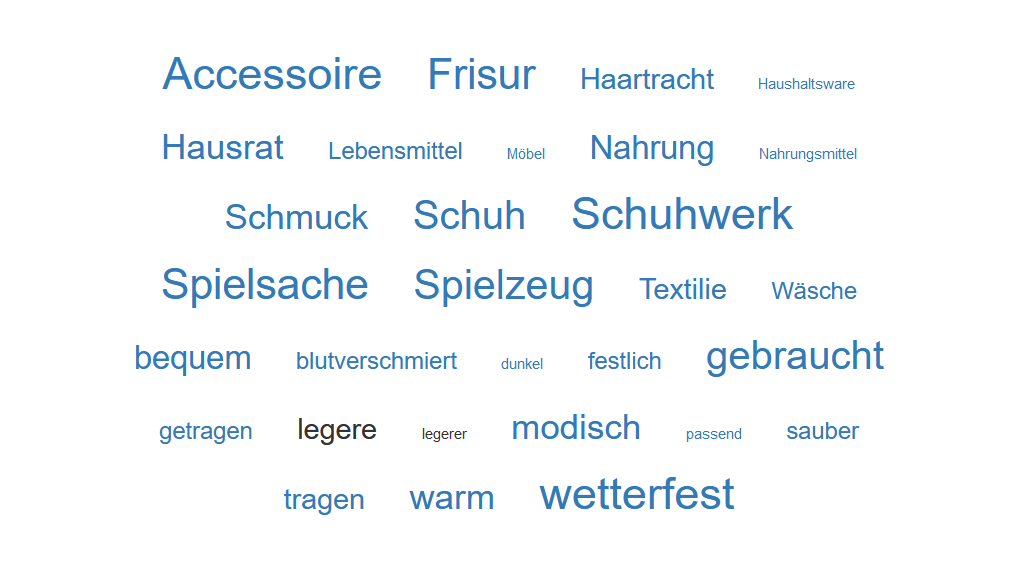Vocabulary Module 6: Kleidung
In this module, you will learn some vocabulary to talk about clothing (die Kleidung) using Das Digitale Wörterbuch der Deutschen Sprache (DWDS), a large electronic collection of German texts known as a corpus. Let’s explore what words German speakers use to talk about clothing. Go to the DWDS homepage and type Kleidung in the search box. You will be taken to a page that gives you a lot of information about this word, but we will focus on the so-called ‘word cloud’ which is available in the Typische Verbindungen section.

The word cloud above shows words that commonly occur with the word Kleidung. They are called collocates of Kleidung. The larger the word is in the cloud, the more frequently it co-occurs with Kleidung. You can also see a numerical representation of the frequency of co-occurrence by looking at the Überblick table for Kleidung accessible through the Detailliertere Informationen link above the word cloud.
Activity 1
Now, let’s review the meaning of some German adjectives that are frequently used with Kleidung by matching them with their English equivalents. If needed, you can consult the online dictionary LEO.
Let’s explore some of the collocates of Kleidung with the help of the DWDS corpus.
Activity 2
Now go to the DWDS page for elegant. When you get there, scroll down to the Typische Verbindungen section to find the word cloud that you will need to complete the activities that follow.
A.
Look at the information you have pulled up for elegant and find the four nouns that you see there.
B.
Some frequently used words with elegant are the nouns Abendkleid, Anzug, Kleid and Kostüm. Can you figure out what they mean?
To see more collocates of elegant, click the Detailliertere Informationen link above its word cloud. To see sentence usage examples, click on words listed in tables. E.g.:
- Das Kleid war elegant und aufregend.
- Die junge deutsche Designerin Brigitte Sievering präsentierte elegante Abendkleider.
Activity 3
Now let’s try to find out more about the use of wetterfest, a collocate of Kleidung. Do a search in the DWDS for the word wetterfest and scroll down to the word cloud. Which items of clothing listed below can be wetterfest?
To see more collocates of wetterfest, click the link Detaillierte Informationen above its word cloud. To see sentence usage examples, click on words listed in tables. E.g.:
- Eine wetterfeste Jacke sollte dabei ständiger Begleiter sein.
Activity 4
Let’s learn more collocates of Kleidung. Click the Detailliertere Informationen link above the word cloud for Kleidung and scroll down to the table hat in Koordination mit. What 5 things are associated with Kleidung?
To see sentence usage examples, click on words listed in the table hat in Koordination mit. E.g.:
- In unserer Ballettschule gibt es strenge Vorschriften, was Kleidung und Frisuren betrifft.
Activity 5
Now let’s find out more about one of the collocates of Kleidung: Schuh. Do a search in the DWDS for the word Schuh and go to the Typische Verbindungen section.
A.
Some adjectives frequently used with Schuh are hochhackig, bequem, and flach. Can you figure out what they mean? To see more collocates of Schuh, click the link Detaillierte Informationen above its word cloud.
B.
Read the sentences below, which contain examples of expressions with Schuh taken from the DWDS corpus.
What is the closest English meaning for these expressions? Select the appropriate answer.
Activity 6
It is important to learn the German nouns together with their articles. Look at the 12 nouns that are associated with Kleidung in the list below and identify 4 nouns that go with der, 4 nouns that go with die, and 4 nouns that go with das.
Activity 7
Next, read the sentences below, which contain examples of idioms with Kleidung taken from the DWDS corpus die ZEIT.
- Die Hosen anhaben:
- Womit erklärt ist, weshalb meistens die Männer die Hosen anhaben.
Die Zeit, 02.05.1986, Nr. 19 - Frauen, die in der Ehe die Hosen anhaben, müssen oft feststellen, daß ihre Rivalin den Nerzmantel trägt.
Die Zeit, 06.11.1992, Nr. 46
- Womit erklärt ist, weshalb meistens die Männer die Hosen anhaben.
- Den Gürtel enger schnallen:
- Die Menschen mussten fast zehn Jahre lang den Gürtel enger schnallen.
Die Zeit, 17.01.2016 (online) - Selbst sparen, länger arbeiten oder einfach den Gürtel enger schnallen.
Die Zeit, 20.01.2005, Nr. 04
- Die Menschen mussten fast zehn Jahre lang den Gürtel enger schnallen.
- Sich auf die Socken machen:
- Sommerzeit schürt Wanderlust, und wären wir nicht so ein Volk von Sommerlochis, wir hätten uns längst selbst auf die Socken gemacht.
Die Zeit, 13.08.2015, Nr. 33 - Die sollen sich bloß auf die Socken machen und Arbeit finden.
Die Zeit, 25.10.1985, Nr. 44
- Sommerzeit schürt Wanderlust, und wären wir nicht so ein Volk von Sommerlochis, wir hätten uns längst selbst auf die Socken gemacht.
What is the closest English meaning for those idioms?
Note that different words may be used in English and German even in idioms that are similar, e.g., anhaben (to have on) vs. tragen (to wear).
Activity 8
On your own. Using the words from this module, write 5-6 sentences about clothing and accessories. If you would like to use adjectives, pay careful attention to which nouns and adjectives frequently go together! If you want, you may add in any idiomatic expressions that you have learned.
For example:
Ich trage gern flache Schuhe.
Meine Lieblingsaccessoires sind Schmuck und Handtaschen.
Ich habe viel zu tun und muss mich auf die Socken machen!
Schirin Kourehpaz & Nina Vyatkina

